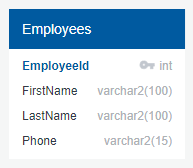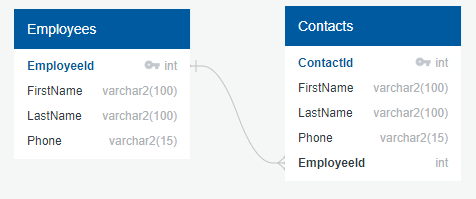Summary: in this tutorial, you will have an overview of the Oracle Database, its features, and editions.
What is a database
A database is an organized collection of structured data stored electronically in a computer system.
When the computer was first invented, it was mainly used for scientific researches to perform calculations quickly.
Since the computer was adopted more and more, the requirements were also increased to require the computer to store a larger volume of data for fast retrieval.
Before the database system was invented, the flat file structure was commonly used to store data. For example, here is the comma-separated value (CSV) file that stores employee information:
first name, last name, phone
John, Doe, (408)-245-2345
Jane, Doe, (503)-234-2355
...
The CSV file has three columns which are known as fields and rows which are known as records. When the number of rows in the flat file is increased e.g., million rows, it becomes unmanageable.
In the 1970s, Dr. Ted Codd, a computer scientist, invented the relational model for database management. The relational model deals with many issues caused by the flat file model. According to his model, data is organized in entities and attributes, instead of combining everything in a single structure.
An entity is a person, place, or thing and attributes describe the person, place, and thing. For example, you can use the relational model to organize the employee information into an employee entity with the attributes: first name, last name, and phone:

Each employee may have one or more contacts, you can create a contact entity and relate the employee entity to the contacts entity through a relationship called one-to-many.

By the way, we often refer to the entities as tables, records as rows, and fields as columns.
The relational model is better than the flat file model because it removes the duplicate data e.g. if you put employee and contact information on the same file. The employee, who has more than one contact, will appear in multiple rows.
The Relational Database Management System, or RDBMS in short, manages relational data. Oracle Database is an RDBMS with the largest market share.
Besides the Oracle Database, there are other RDBMS products available. Here are some notable ones:
- Db2 from IBM.
- SQL Server from Microsoft.
- MySQL – the most popular open-source database, also from Oracle.
- PostgreSQL – the most advanced open source database.
Oracle Database features
Oracle Database allows you to quickly and safely store and retrieve data. Here are the integration benefits of the Oracle Database:
- Oracle Database is cross-platform. It can run on various hardware across operating systems including Windows Server, Unix, and various distributions of GNU/Linux.
- Oracle Database has its networking stack that allows application from a different platform to communicate with the Oracle Database smoothly. For example, applications running on Windows can connect to the Oracle Database running on Unix.
- ACID-compliant – Oracle is ACID-compliant Database that helps maintain data integrity and reliability.
- Commitment to open technologies – Oracle is one of the first Database that supported GNU/Linux in the late 1990s before GNU/Linux become a commerce product. It has been supporting this open platform since then.
Oracle Database has several structural features that make it popular:
- Logical data structure – Oracle uses the logical data structure to store data so that you can interact with the database without knowing where the data is stored physically.
- Partitioning – is a high-performance feature that allows you to divide a large table into different pieces and store each piece across storage devices.
- Memory caching – the memory caching architecture allows you to scale up a very large database that still can perform at a high speed.
- Data Dictionary is a set of internal tables and views that support administer Oracle Database more effectively.
- Backup and recovery – ensure the integrity of the data in case of system failure. Oracle includes a powerful tool called Recovery Manager (RMAN) – allows DBA to perform cold, hot, and incremental database backups and point-in-time recoveries.
- Clustering – Oracle Real Application Clusters (RAC) – Oracle enables high availability that enables the system is up and running without interruption of services in case one or more server in a cluster fails.
Oracle Database Editions
Oracle provides three main editions of Oracle Databases as follows:
1) Enterprise Edition (EE) is the common and expensive edition of the Oracle Database. It has the following characteristics:
- No maximum number of CPUs
- No limits on memory or database size
- Include premium features that are not available in other editions.
2) Standard Edition (SE) is a limited edition of the Enterprise Edition that has the following characteristics:
- Limited to four or fewer CPUs
- No limit on memory or database size
- Include many features, but no as many as EE
3) Expression Edition (XE) is a free-to-use version of the Oracle Database that is available on both Windows and GNU/Linux platforms. These are the features of Oracle Database XE 18c:
- Limited to 2 CPUs
- Can use the maximum of 2GB of RAM, and has 12GB of user data.
- Very limited features
In this tutorial, you have learned about the Oracle Database, its notable features, and editions.